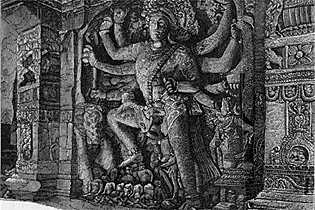 |
 |
Harper's Weekly
November 6, 1875
| "Ellora, a decayed town in Hyderabad, derives its celebrity chiefly from the remarkable excavations in the neighboring mountain, known as the temples of Ellora. According to Hindoo legend, the date of these temples is carried back for a period of 7950 years, and their origin ascribed to Rajah Eeloo, the son of Peshfont, of Ellichpore, when 3000 years of the Dwarpa Yoag were yet unaccomplished. The more rational account of the Mohammedans states that the 'town of Ellora was built by Rajah Eel, who also excavated the temples, Rajah Eel was contemporary with Shah Momin Arif,' who lived 950 years ago. According to Elphinstone, however, the first mention in history of these caves occurs in connection with the Princess Dewal Devi, daughter of the Rajah of Guzerat, who was captured by a party who had gone from the camp of Alp Khan to visit the excavations at Ellora. |
| "Elephanta, in the presidency of Bombay, is a small island on the east side of the harbor of Bombay, and distant about five miles from the mainland. It is something less than size miles in circumference, and is composed of two long hills, with a narrow valley between them. The usual landing-place is toward the south, where the valley is broadest. Some distance to the right of the landing-place is a large clumsy figure of an elephant, cut out of an insulated black rock; and from this circumstance the island (which by the natives is called Gara-pori) has derived the denomination by which it is known to Europeans. |
| "This huge figure, which is thirteen feet in length, is represented as much mutilated and rapidly sinking into total decay, its head and neck having in 1814 fallen from the rest of the body, which was also fast coming to the ground, an extensive fissure having taken place in the back. On advancing farther from the landing-place, the visitor comes suddenly in front of the grand entrance of a magnificent temples, whose huge massy columns seem to give support to the whole mountain whicn rises above it, and out of which it is hewn. The entrance is by a spacious front, supported by two ponderous pillars and two pilasters, forming three openings, under a thick and steep rock, overhung by brushwood; and the impression on reaching the interior is rendered very deep and solemn by the long ranges of columns that appear closing in perspective on every side; the flat roof of solid rock that seems to be prevented from falling only by the massive pillars whose capitals are pressed down and flattened, as if by the superincumbent weight; the darkness that obscures the interior of the temple, which is dimly lighted only from the entrances; and the gloomy appearance of the gigantic stone figures ranged along the wall, and hewn out of the living rock. |
| "There are three principal parts in this extraordinary work - the great temples, 133 feet broad and 130 1/2 feet long, and two smaller temples, one on each side of the principal one. These two appendant temples do not range in a straight line with the front of the principal one, but recede considerably from it, being approached by two narrow passes in the hill, one on each side of the grand entrance, but at some distance therefrom. Each of ehse passes conducts also to a side front of the grand excavation, exactly like the principal front, consisting of two huge pillars with two pilasters. These two side fronts are precisely opposite to each other, on the east and west, the grand entrance facing north; and the plan is regular, there being eight pillars and pilasters in a line from the northern entrance to the southern extremity, and the same number from the eastern to the western entrance." |
|
|